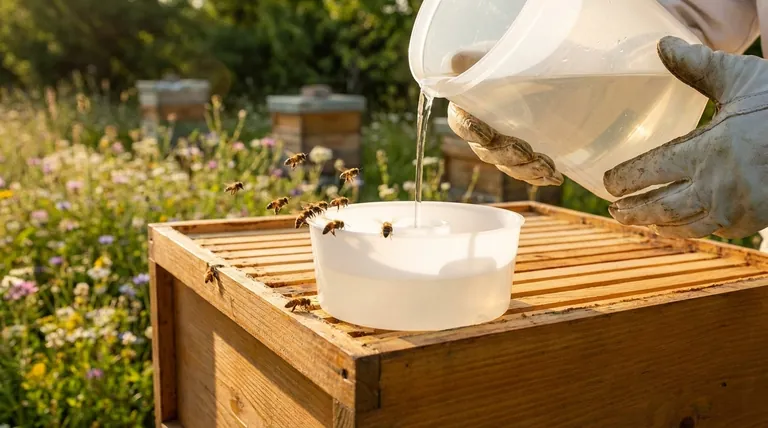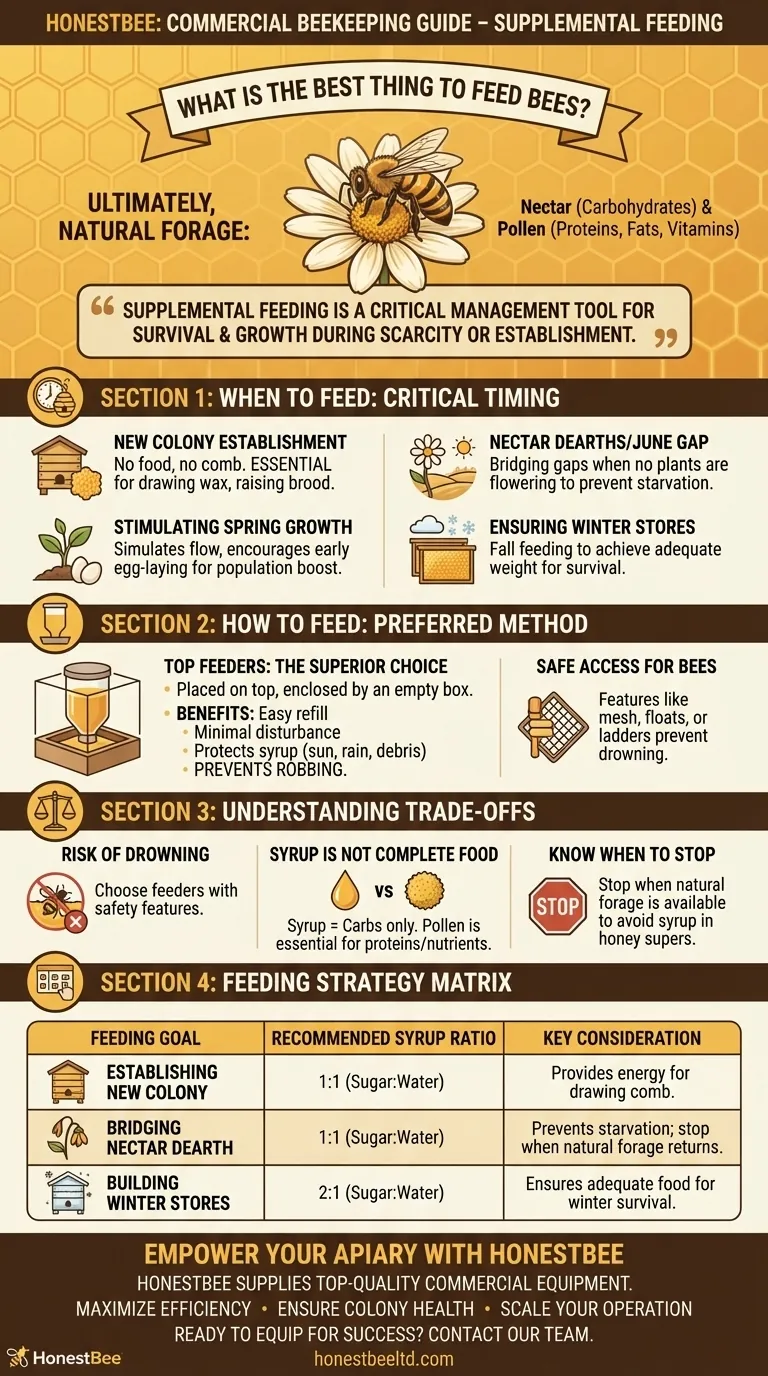Ultimately, a bee's best food is what it makes and forages for itself. Honey provides carbohydrates for energy, and natural pollen provides the essential proteins, fats, and vitamins required for raising brood and overall colony health. When beekeepers need to intervene, however, the standard practice is to provide a substitute, typically sugar syrup.
While a healthy colony in a resource-rich environment needs no help, supplemental feeding is a critical management tool for ensuring a hive's survival and growth during periods of scarcity or establishment. The key is not just what you feed, but when and how you do it.

Understanding the Need for Supplemental Feeding
Bees are incredibly self-sufficient, but modern beekeeping practices and environmental challenges can create situations where a colony requires support to thrive.
The Most Critical Time: Establishing a New Colony
When you first install a package of bees or a small nucleus colony, they have no stored food, no drawn-out comb, and no established foraging patterns.
Providing a steady supply of sugar syrup at this stage is essential. It gives them the energy needed to draw wax comb, begin raising brood, and build up the resources required to become self-sufficient.
Bridging Gaps in Nectar Flow
Even in areas with good forage, there can be periods when no plants are flowering. This is often called a "nectar dearth" or, in some regions, the "June gap."
Feeding during these times prevents the colony from consuming all its winter stores or seeing a decline in its population due to a lack of incoming resources.
Stimulating Spring Growth
A light feeding in early spring can simulate a natural nectar flow. This encourages the queen to begin laying eggs earlier, helping the colony build its population in time for the main honey flow.
Ensuring Adequate Winter Stores
In the fall, a beekeeper must ensure the colony has enough honey stored to survive the long winter months. If their stores are insufficient, feeding a heavy sugar syrup is necessary to prevent starvation.
The How: Delivery Method Matters
Providing food is only half the battle; delivering it safely and effectively is just as important. The consensus among experienced beekeepers points toward top feeders as the superior method.
Why Top Feeders Are Preferred
Top feeders are placed directly on top of the uppermost hive body, enclosed by an empty box and the hive cover. This design offers several distinct advantages.
They are incredibly easy to refill with minimal disturbance to the colony. You can simply lift the hive cover and pour in more syrup without breaking open the main brood nest.
This enclosed system also protects the syrup from sun, rain, and debris. Crucially, it helps prevent robbing by bees from other hives and access by pests, which can be a major problem with external or entrance feeders.
Safe Access for Bees
Good top feeders provide a way for bees to access the syrup without the risk of drowning. Many use a mesh-covered hole or internal floats that allow bees to drink safely from a central reservoir.
Understanding the Trade-offs
While supplemental feeding is a powerful tool, it must be used thoughtfully. It is an intervention with specific goals, not a replacement for a bee's natural diet.
The Risk of Drowning
Some feeder designs, particularly those with large, open reservoirs of syrup, pose a significant drowning risk. Always choose a model that incorporates safety features like floats, screens, or ladders to give bees a safe place to stand.
Syrup Is Not a Complete Food
Remember, sugar syrup only provides carbohydrates (energy). It is a direct substitute for nectar or honey. It contains none of the proteins, lipids, or micronutrients found in pollen.
A colony fed only syrup can still suffer from nutritional deficiencies if it does not have access to adequate natural or supplemental pollen sources. Real pollen is always best, but it is expensive and often unnecessary if natural sources are available.
Know When to Stop
Once a new colony is established with drawn comb and stored food, or when a natural nectar flow begins, it is time to stop feeding. Continuous feeding can result in syrup being stored in the honey supers, which is not desirable.
Making the Right Choice for Your Colony
Your feeding strategy should be dictated by your specific goal for the colony at that moment.
- If your primary focus is establishing a new colony: Feed a consistent supply of 1:1 sugar syrup using a top feeder until the bees have drawn out comb on most of their frames.
- If your primary focus is supporting a colony through a nectar shortage: Provide syrup in a top feeder to sustain the colony, but monitor natural forage and stop feeding as soon as it becomes available.
- If your primary focus is preparing a light hive for winter: Use a top feeder to provide a heavy 2:1 sugar syrup in the fall until the colony has reached its target weight for winter survival.
Thoughtful feeding is a hallmark of a proactive beekeeper, empowering your colonies to overcome challenges and thrive.
Summary Table:
| Feeding Goal | Recommended Syrup Ratio | Best Feeder Type | Key Consideration |
|---|---|---|---|
| Establishing a New Colony | 1:1 (Sugar:Water) | Top Feeder | Provides energy for drawing comb. |
| Bridging a Nectar Dearth | 1:1 (Sugar:Water) | Top Feeder | Prevents starvation; stop when natural forage returns. |
| Building Winter Stores | 2:1 (Sugar:Water) | Top Feeder | Ensures adequate food for winter survival. |
Empower Your Apiary with the Right Equipment
As a commercial beekeeper or equipment distributor, the health of your colonies depends on reliable, efficient tools. Supplemental feeding is a critical management practice, and using the right feeder is paramount to success.
HONESTBEE supplies top-quality beekeeping supplies and equipment designed for the demands of commercial-scale operations. We help you:
- Maximize Efficiency: Our top feeders minimize disturbance and prevent robbing, saving you time and protecting your investment.
- Ensure Colony Health: Provide the right support at the right time with equipment built for safety and effectiveness.
- Scale Your Operation: Source durable, wholesale-focused equipment to support your growth.
Ready to equip your apiary for success? Contact our team today to discuss your wholesale needs and how HONESTBEE can be your trusted partner in beekeeping.
Visual Guide

Related Products
- Rapid Bee Feeder White Plastic 2L Round Top Feeder for 8 or 10-Frame Bee Hives
- HONESTBEE Advanced Ergonomic Stainless Steel Hive Tool for Beekeeping
- Professional Dual-End Stainless Steel Hive Tool for Beekeeping
- Professional 3-Bar Frame Grip with Integrated Hive Tool
- Beehive Handle and Frame Rest Cutting Machine: Your Specialized Hive Machine
People Also Ask
- What is the advice regarding feeding bees to limit brood production based on? Managing Prolific Bee Strains
- How do you set up and use a top feeder for bees? A Step-by-Step Guide for Safe Feeding
- Can you dilute honey and feed it to the bees? Understand the Critical Risks and Safe Practices
- Do beekeepers leave honey for bees? The Essential Guide to Sustainable Hive Management
- What are the recommended sugar-to-water ratios for making sugar syrup for bees? Optimize Your Hive's Health



















